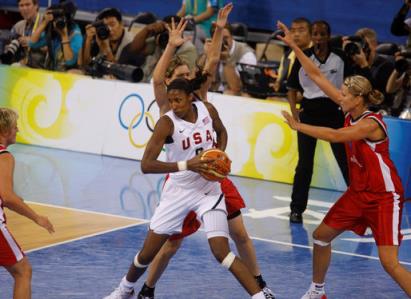Sports
Basketball Positions
Basketball Rules
Player
Positions Basketball
Strategy
Basketball
Glossary
Back to Sports
Back to Basketball
The rules of basketball do not define any specific player positions. This is different from many other major sports like football, baseball, and soccer where at least some players must be in certain positions during the play of the game (the goalie in soccer, for example). So the positions in basketball are more part of an overall strategy of the game. There are 5 traditional positions that most teams have in their offense and defensive schemes. Many players today are interchangeable or can play many positions. Also, many teams have rosters and players that allow them to try different set ups like a three guard offense, for example.

Lisa Leslie typically played the center position
Source: The White House
The five traditional basketball player positions are:
Point guard: The point guard is the team leader and play caller on the basketball court. A point guard needs good ball handling skills, passing skills as well as strong leadership and decision making skills. Traditionally basketball point guards were small, fast players and this is still often the case. However, Magic Johnson changed the way point guards were used. He was a big 6-8 player that used his height and size to get great passing angles. Magic's success has opened the door for all sorts of point guards. The key to a strong point guard today is leadership, passing, and running the team.
Shooting guard: The shooting guard in basketball has the main responsibility of making long outside shots including the three-point shot. The shooting guard also should be a good passer and able to help the point guard with the ball handling. Shooting guards are often the top scorer on a team. Perhaps the best shooting guard in the history of basketball was Michael Jordan. Jordan could do it all, from scoring to defense to rebounding. It's this versatility that makes a great shooting guard, but all shooting guards should be able to extend the defense with their outside shot.
Small forward: Along with the shooting guard, the small forward is often the most versatile player on the basketball team. They should be able to help with ball handling, make an outside shot, and get rebounds. The small forward is often a great defensive player as well. The combination of height and quickness can allow them to defend a number of positions and take on the best scorer on the opposing team. On many teams today the small forward and the shooting guard are almost the same position and are called "wing" players.
Power forward: The power forward on a basketball team is usually responsible for rebounding and some scoring in the paint. A power forward should be big and strong and able to clear out some space under the basket. Many great power forwards in the game today do not score a lot of points, but lead their team in rebounds. Power forwards are often good shot blockers as well.
Center: The center is usually the biggest or tallest member of the basketball team. In the NBA, many centers are 7 feet tall or taller. The center can be a big scorer, but also needs to be a strong rebounder and shot blocker. On many teams the center is the final line of defense. Many of basketball's greatest players (Wilt Chamberlain, Bill Russell, Kareem, Shaq) have been centers. A strong center presence was long considered the only way to win an NBA championship. In modern times, many teams have won with other great players (Michael Jordan), but a strong center is still a prized basketball position on any basketball team.
Bench: Although only 5 players play at a time on any basketball team, the bench is still very important. Basketball is a fast paced game and players need to rest. A strong bench is key to any basketball team's success. In most games at least 3 players from the bench will play a significant amount of time.
Defensive Positions:
There are two main types of defensive basketball strategies: zone and man-to-man. In man-to-man defense each player is responsible to cover one player on the other team. They follow this player wherever they go on the court. In zone defense, players have certain positions or areas of the court they cover. The guards usually play at the top of the key with the forwards playing closer to the basket and on opposite sides. The center usually plays in the middle of the key. However, there are a wide variety of zone defenses and combinations of zone and man-to-man that basketball teams play. Teams will often switch defenses around during a basketball game to see which works best against a particular opponent.
More Basketball Links:
Back to Basketball
Back to Sports
